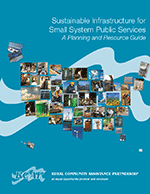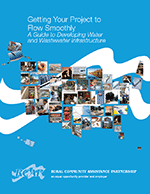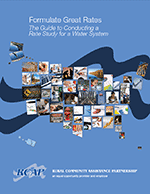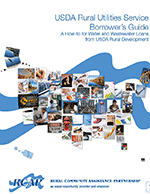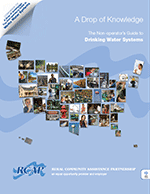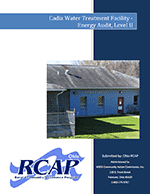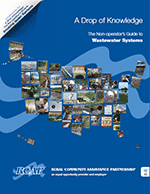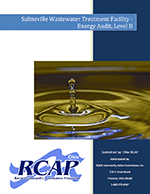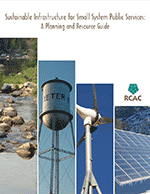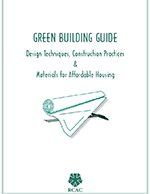-
Sustainable Infrastructure for Small System Public Services
A Planning and Resource Guide
At the local level, decision-makers and staff deal with the challenges of operating their small utility on a daily basis. They must make decisions on operating costs, with aging infrastructure, with the pressures of increasing regulatory compliance, with volunteer burnout, and many other factors. Put together with the growth of sustainability as a measure of a utility’s success, the processes of incorporating “green” practices can further burden a small utility.
This planning and resource guide is a starting place for very small (fewer than 1,000 connections) to medium (up to 5,000 connections) communities to initiate and integrate green elements in their facilities and projects. (RCAP publication 2011.)
Read More -
Getting Your Project to Flow Smoothly
A Guide to Developing Water and Wastewater Infrastructure
There is an infrastructure crisis currently facing both small and large water and waste waster systems in our country. This crisis results from a perfect storm created by an increasing lack of public resources, years of neglect, and mounting regulatory demands and restrictions. Moreover, many rural areas are struggling economically. The need to diversify economies and protect environmental resources increases pressure to develop or upgrade infrastructure. In the race to revitalization, communities that make wise investments in infrastructure will be more likely to succeed. (RCAP publication 2011.)
Read More -
Formulate Great Rates
The Guide to Conducting a Rate Study for a Water System
As a board member or officer of your community’s water system, you have a very important responsibility to your community. Your job is to ensure that the water system provides residents with an adequate supply of high quality drinking water delivered at a price that not only covers all of the costs of providing the service but also allows the system to prepare and plan for providing that service for many years to come. You must ensure that the water meets all regulatory standards, is reliable, and that there is sufficient quantity for all current and future users. When you consider everything that goes into providing safe, clean and affordable drinking water, it can sometimes seem like a daunting responsibility. (RCAC publication 2011.)
Formulate Great Rates Worksheet
Read More -
USDA Rural Utilities Service Borrower's Guide
A How-to for Water and Wastewater Loans from USDA Rural Development
This guide is for leaders and officials of a community that is an RUS water or waste-disposal borrower. You are required to follow specific management practices and reporting guidelines with the funds you have borrowed for your small community’s utility. This booklet is a practical toolkit and guide to RUS financing and staying on track with both deadlines for management reports and, most critically, learning which forms to use and how to use them. (RCAP publication 2011.)
Read More -
The Non-operator's Guide to Drinking Water Systems
Most of us take our drinking water for granted. We turn on the tap, and, with very few exceptions, we have clean, safe water. While clean water is available nearly everywhere and is simple to get through a faucet in a home, what goes on behind the scenes to provide it is very complex and requires the input of many parts and people. Water is such an ordinary and everyday part of our lives, yet it requires so much to get it to us—strict health regulations, a knowledge of chemical, biological and technical processes, budgeting to run a business, and miles of infrastructure to make it convenient to get, to name just a few things. (RCAP publication 2011.)
Read More -
Cadiz Water Treatment Facility - Energy Audit, Level II
Representatives from the Ohio Rural Communities Assistance Program (Ohio RCAP) conducted a Level II Energy Audit for the Cadiz, Ohio Water Treatment Facility on November 9, 2010. The purpose of the facility Energy Audit is to gain an understanding of the facility processes and of the major end uses, with an ultimate objective of identifying potential energy conservation opportunities. Utility Superintendent Thomas Carter and Ohio Mid-Eastern Governments Association Project Manager Cindi Kerschbaumer were also present during the site visit.
This Level II Energy Audit, herein referred to as the Audit, is a continuance of technical assistance provided through the USDA Rural Community Development Initiative by Ohio RCAP. (Published 2011.)
Read More -
The Non-operator's Guide to Wastewater Systems
Most of us take our wastewater (sewer) systems for granted. We flush the toilet or wash the dishes or our clothes, and, with very few exceptions, the dirty water leaves our home. While most of the time our wastewater is out of sight and out of mind, what goes on behind the scenes to carry out this important function is very complex and requires the input of many parts and people. We all generate gallons of wastewater every day and often don’t think about how it is dealt with, yet it often requires so much to provide this service to us—strict health regulations, a knowledge of chemical, biological and technical processes, budgeting to run a business, and miles of infrastructure to make it convenient, to name just a few things. (RCAP publication 2011.)
Read More -
Salineville Wastewater Treatment Facility - Energy Audit, Level II
Representatives from the Ohio Rural Communities Assistance Program (Ohio RCAP) conducted a Level II Energy Audit for the Village of Salineville, Ohio Wastewater Treatment Facility on November 18, 2009. The purpose of the facility Energy Audit is to gain an understanding of the Facility processes and of the major end uses, with an ultimate objective of identifying potential energy conservation opportunities. Local representatives were also present during the site visit.
This Level II Energy Audit, herein referred to as the Audit, is a continuance of technical assistance provided through the USDA Rural Community Development Initiative (RCDI) by Ohio RCAP. (Published 2010.)
Read More -
Sustainable Infrastructure for Small System Public Services: A Planning and Resource Guide
Rather than presenting theories, this guidebook provides informational material, worksheets, examples, case studies and resources on water conservation, energy efficiency and renewable energy for small utilities.
This guide includes a step-by-step process for utility decision-makers, staff and community members wanting to operate increasingly efficient utility systems. It offers a flexible approach to evaluating sustainable alternatives for utility operations. (Published 2009.)
Sustainable Infrastructure Guide Supplement
Read More -
Green Building Guide
Design Techniques, Construction Practices & Materials for Affordable Housing
Green building is a time-tested, practical and intuitive approach to creating environmentally sound buildings. Green building combines age-old wisdom; tradition and collaborative design processes; and modern building science, technology and materials application.
Green building structures are energy efficient, conserve resources, create healthier indoor environments and offer durable and beautiful spaces that use environmentally suitable materials. Green building incorporates integrated design concepts, solar orientation, appropriate footprint sizing, glazing awareness, material durability, economic life-cycle analysis, material reuse and salvage, natural material content, locally available materials and economic sustainability. (Published 2009.)
Read More
